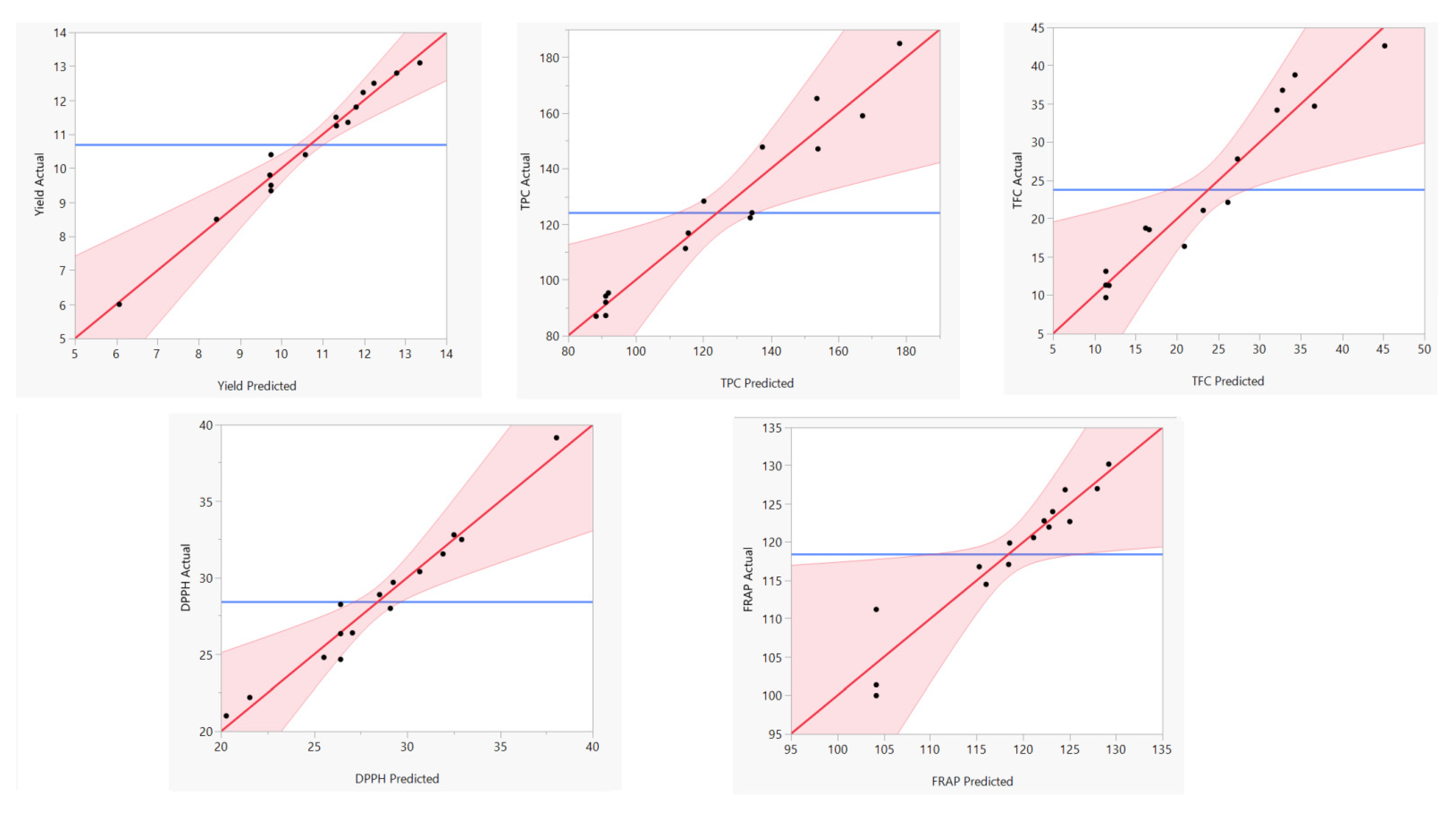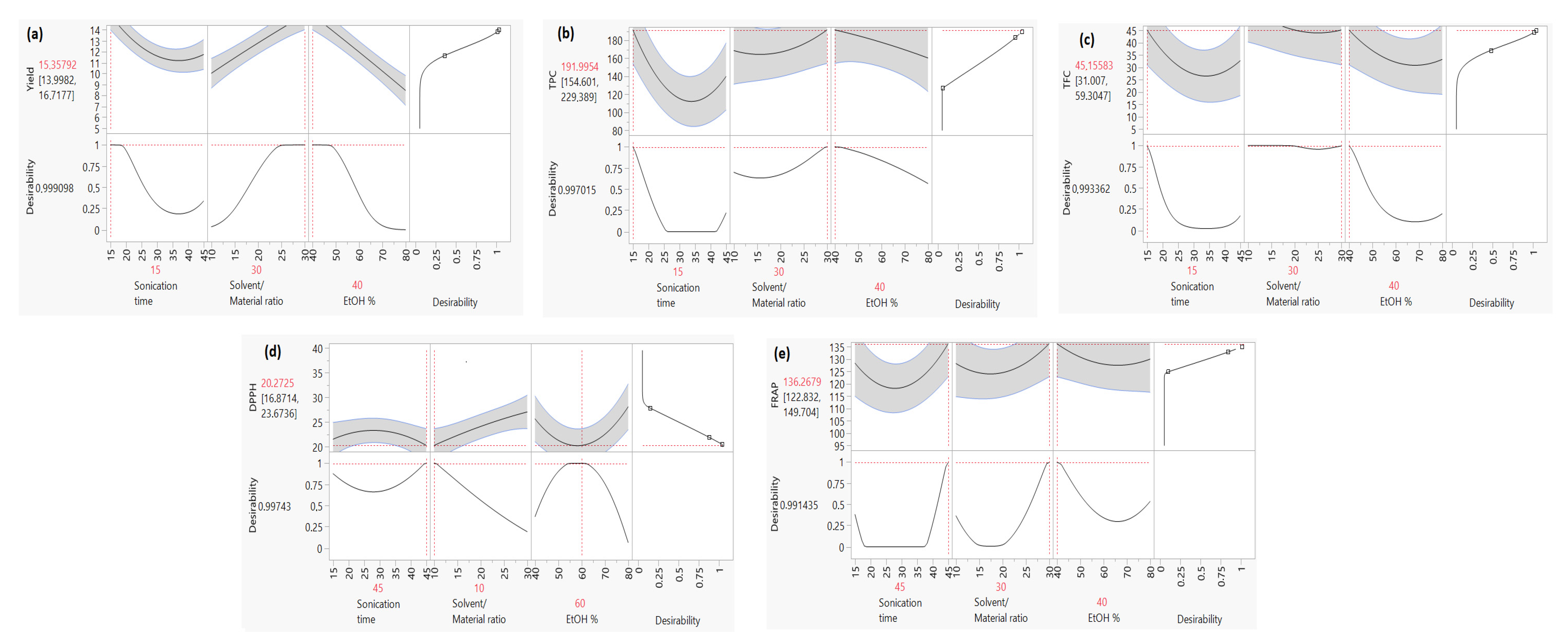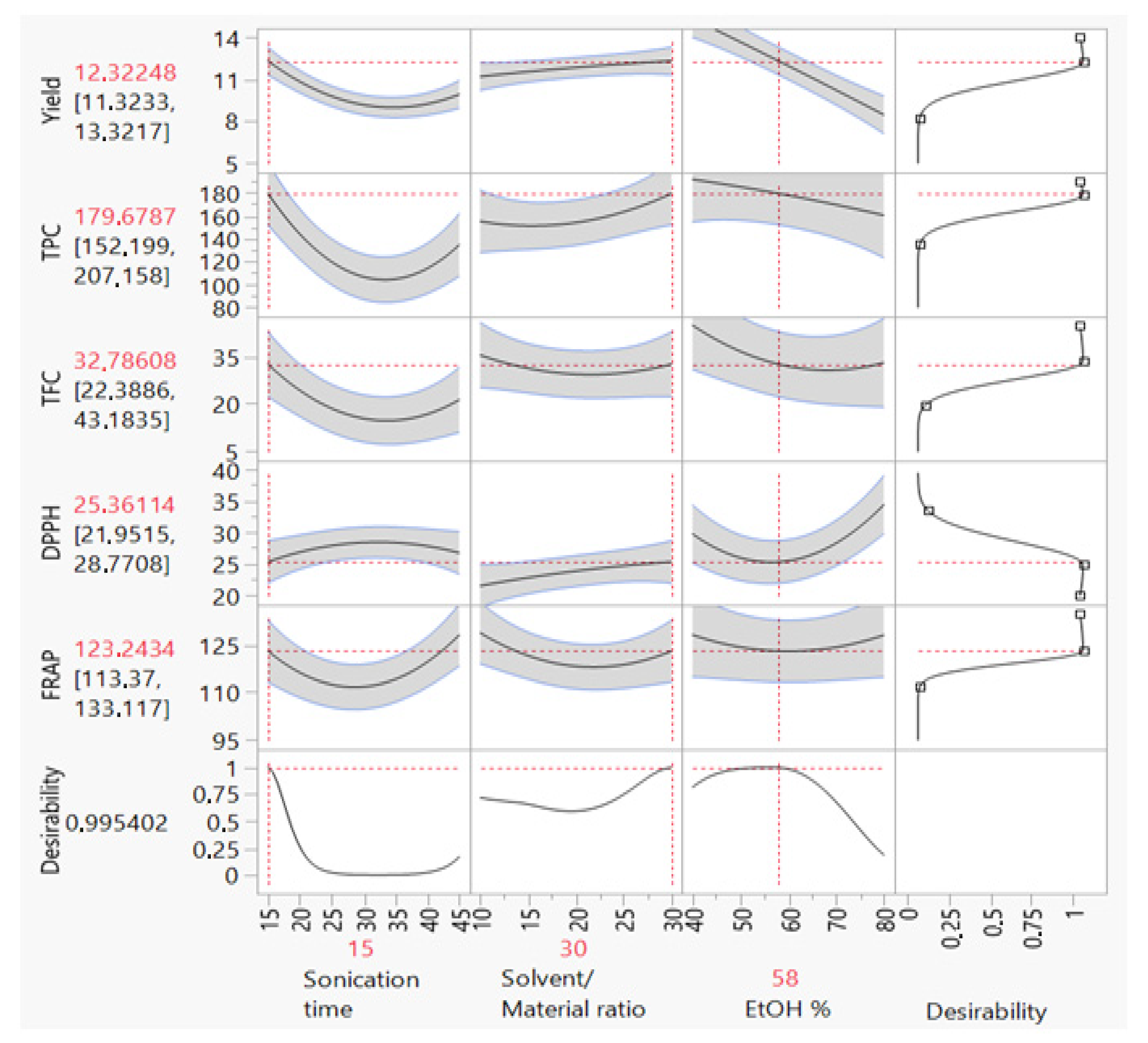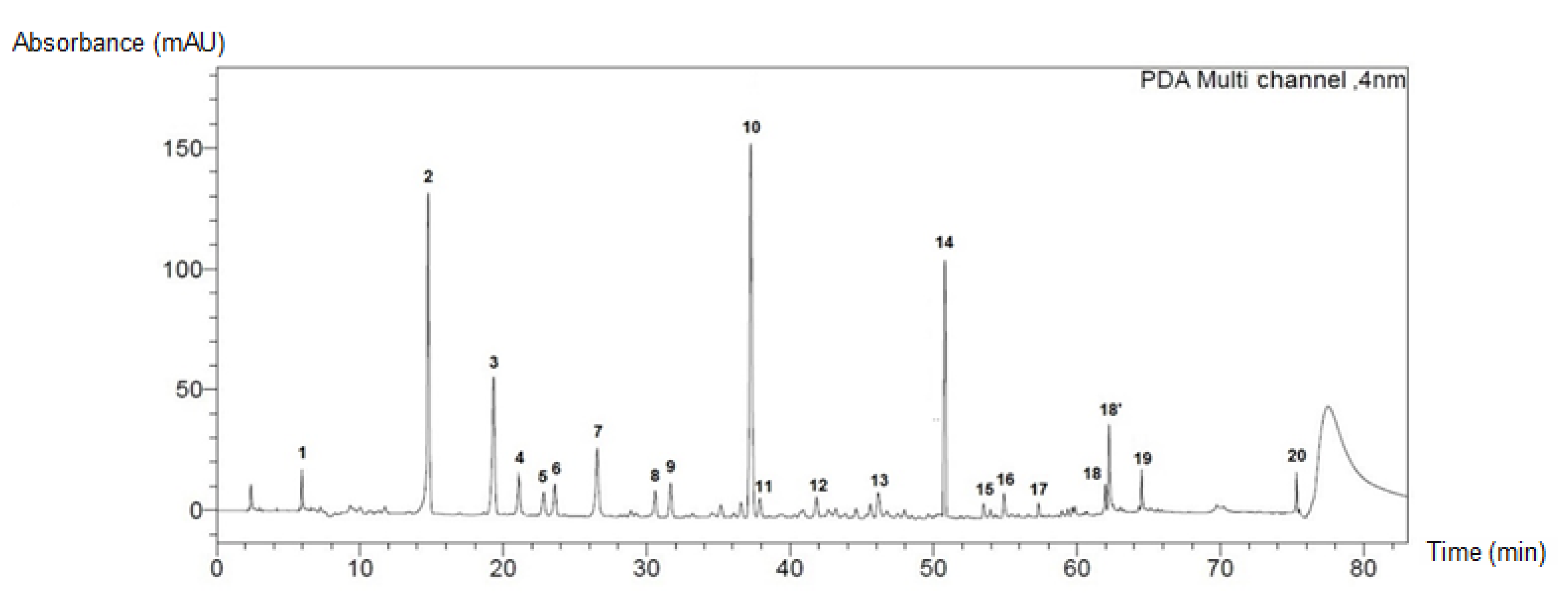Simultaneous Optimization of Extraction Yield, Phenolic Compounds and Antioxidant Activity of Moroccan Propolis Extracts: Improvement of Ultrasound-Assisted Technique Using Response Surface Methodology
Abstract
:1. Introduction
2. Materials and Methods
2.1. Chemicals and Reagents
2.2. Propolis Preparation
2.3. Ultrasound-Assisted Extraction (UAE) Conditions and Yield of Extraction
2.4. Total Phenolic Content Determination
2.5. Total Flavonoids Content Determination
2.6. Diphenyl-1-Picrylhydrazyl (DPPH) Assay
2.7. Ferric-Reducing Antioxidant Power Assay
2.8. HPLC-DAD Analysis
2.9. Experimental Design for Optimization
2.10. Mathematical Model
2.11. Statistical Analysis
2.12. Optimization Tools
3. Results and Discussion
3.1. Box–Behnken Design Results
3.2. Statistical Validation of the Postulated Model
3.3. Model Parameter Estimation and Fitted Models
3.4. Optimization of Ultrasound-Assisted Extraction Parameters
3.4.1. Effect of Operating Conditions on the Propolis Extraction Yield Response
3.4.2. Effect of Operating Conditions on the TPC Response
3.4.3. Effect of Operating Conditions on TFC Response
3.4.4. Effect of Operating Conditions on DPPH-IC50Response
3.4.5. Effect of Operating Conditions on FRAP-EC50 Response
3.4.6. Simultaneous Multi-Response Optimization
3.5. Phenolic Screening of Optimized Extraction of Moroccan Propolis
4. Conclusions
Author Contributions
Funding
Institutional Review Board Statement
Informed Consent Statement
Data Availability Statement
Conflicts of Interest
References
- Alday, E.; Navarro-Navarro, M.; Garibay-Escobar, A.; Robles-Zepeda, R.; Hernandez, J.; Velazquez, C. Advances in Pharmacological Activities and Chemical Composition of Propolis Produced in Americas; IntechOpen: London, UK, 2016. [Google Scholar]
- Widjajanto, E. Identification and Quantification of Propolis’s Active Compound in Various Solvents. J Appl. Environ. Biol. Sci. 2016, 6, 94–99. [Google Scholar]
- Ahangari, Z.; Naseri, M.; Vatandoost, F. Propolis: Chemical composition and its applications in endodontics. Iran. Endod. J. 2018, 13, 285. [Google Scholar] [PubMed]
- Huang, S.; Zhang, C.-P.; Wang, K.; Li, G.Q.; Hu, F.-L. Recent advances in the chemical composition of propolis. Molecules 2014, 19, 19610–19632. [Google Scholar] [CrossRef] [PubMed] [Green Version]
- Anjum, S.I.; Ullah, A.; Khan, K.A.; Attaullah, M.; Khan, H.; Ali, H.; Bashir, M.A.; Tahir, M.; Ansari, M.J.; Ghramh, H.A. Composition and functional properties of propolis (bee glue): A review. Saudi J. Biol. Sci. 2019, 26, 1695–1703. [Google Scholar] [CrossRef]
- Sokeng, S.D.; Talla, E.; Sakava, P.; Fokam Tagne, M.A.; Henoumont, C.; Sophie, L.; Mbafor, J.T.; Tchuenguem Fohouo, F.-N. Anti-inflammatory and analgesic effect of arachic acid ethyl ester isolated from propolis. BioMed Res. Int. 2020, 2020, 8797284. [Google Scholar] [CrossRef] [PubMed]
- Touzani, S.; Embaslat, W.; Imtara, H.; Kmail, A.; Kadan, S.; Zaid, H.; ElArabi, I.; Badiaa, L.; Saad, B. In vitro evaluation of the potential use of propolis as a multitarget therapeutic product: Physicochemical properties, chemical composition, and immunomodulatory, antibacterial, and anticancer properties. BioMed Res. Int. 2019, 2019, 4836378. [Google Scholar] [CrossRef] [PubMed] [Green Version]
- Sepúlveda, C.; Núñez, O.; Torres, A.; Guzmán, L.; Wehinger, S. Antitumor activity of propolis: Recent advances in cellular perspectives, animal models and possible applications. Food Rev. Int. 2020, 36, 429–455. [Google Scholar] [CrossRef]
- Campos, J.F.; dos Santos, U.P.; Macorini, L.F.B.; de Melo, A.M.M.F.; Balestieri, J.B.P.; Paredes-Gamero, E.J.; Cardoso, C.A.L.; de Picoli Souza, K.; dos Santos, E.L. Antimicrobial, antioxidant and cytotoxic activities of propolis from Melipona orbignyi (Hymenoptera, Apidae). Food Chem. Toxicol. 2014, 65, 374–380. [Google Scholar] [CrossRef]
- Laaroussi, H.; Bakour, M.; Ousaaid, D.; Aboulghazi, A.; Ferreira-Santos, P.; Genisheva, Z.; Teixeira, J.A.; Lyoussi, B. Effect of antioxidant-rich propolis and bee pollen extracts against D-glucose induced type 2 diabetes in rats. Food Res. Int. 2020, 138, 109802. [Google Scholar] [CrossRef]
- Laaroussi, H.; Ferreira-Santos, P.; Genisheva, Z.; Bakour, M.; Ousaaid, D.; Teixeira, J.A.; Lyoussi, B. Unraveling the chemical composition, antioxidant, α-amylase and α-glucosidase inhibition of Moroccan propolis. Food Biosci. 2021, 42, 101160. [Google Scholar] [CrossRef]
- Šuran, J.; Cepanec, I.; Mašek, T.; Radić, B.; Radić, S.; Tlak Gajger, I.; Vlainić, J. Propolis extract and its bioactive compounds—From traditional to modern extraction technologies. Molecules 2021, 26, 2930. [Google Scholar] [CrossRef] [PubMed]
- Bankova, V.; Trusheva, B.; Popova, M. Propolis extraction methods: A review. J. Apic. Res. 2021, 60, 734–743. [Google Scholar] [CrossRef]
- Li, X.; Zhu, F.; Zeng, Z. Effects of different extraction methods on antioxidant properties of blueberry anthocyanins. Open Chem. 2021, 19, 138–148. [Google Scholar] [CrossRef]
- Pellati, F.; Prencipe, F.P.; Bertelli, D.; Benvenuti, S. An efficient chemical analysis of phenolic acids and flavonoids in raw propolis by microwave-assisted extraction combined with high-performance liquid chromatography using the fused-core technology. J. Pharm. Biomed. Anal. 2013, 81, 126–132. [Google Scholar] [CrossRef] [PubMed]
- Kim, S.-H.; Kim, I.-H.; Kang, B.-H.; Lee, K.-H.; Lee, S.-H.; Lee, D.-S.; Cho, S.-M.K.; Hur, S.-S.; Kwon, T.-K.; Lee, J.-M. Optimization of ethanol extraction conditions from propolis (a bee product) using response surface methodology. Korean J. Food Preserv. 2009, 16, 908–914. [Google Scholar]
- Bakkaloglu, Z.; Arici, M.; Karasu, S. Optimization of ultrasound-assisted extraction of turkish propolis and characterization of phenolic profile, antioxidant and antimicrobial activity. Food Sci. Technol. 2021, 41, 687–695. [Google Scholar] [CrossRef]
- Pan, G.; Yu, G.; Zhu, C.; Qiao, J. Optimization of ultrasound-assisted extraction (UAE) of flavonoids compounds (FC) from hawthorn seed (HS). Ultrason. Sonochem. 2012, 19, 486–490. [Google Scholar] [CrossRef]
- Mirhosseini, H.; Tan, C.P.; Hamid, N.S.A.; Yusof, S. Modeling the relationship between the main emulsion components and stability, viscosity, fluid behavior, ζ-potential, and electrophoretic mobility of orange beverage emulsion using response surface methodology. J Agric. Food Chem. 2007, 55, 7659–7666. [Google Scholar] [CrossRef] [PubMed]
- Boisard, S.; Le Ray, A.-M.; Gatto, J.; Aumond, M.-C.; Blanchard, P.; Derbré, S.; Flurin, C.; Richomme, P. Chemical composition, antioxidant and anti-AGEs activities of a French poplar type propolis. J. Agric. Food Chem. 2014, 62, 1344–1351. [Google Scholar] [CrossRef] [Green Version]
- Yusof, N.; Munaim, M.S.A.; Veloo Kutty, R. Optimization of total phenolic compounds extracted from propolis by ultrasound-assisted extraction. Chem. Eng. Commun. 2021, 208, 564–572. [Google Scholar] [CrossRef]
- Oroian, M.; Dranca, F.; Ursachi, F. Comparative evaluation of maceration, microwave and ultrasonic-assisted extraction of phenolic compounds from propolis. J. Food Sci. Technol. 2020, 57, 70–78. [Google Scholar] [CrossRef] [PubMed]
- Isla, M.I.; Salas, A.; Danert, F.C.; Zampini, I.C.; Ordonez, R.M. Analytical methodology optimization to estimate the content of non-flavonoid phenolic compounds in Argentine propolis extracts. Pharm. Biol. 2014, 52, 835–840. [Google Scholar] [CrossRef] [PubMed] [Green Version]
- Pontis, J.A.; Costa, L.A.M.A.D.; Silva, S.J.R.D.; Flach, A. Color, phenolic and flavonoid content, and antioxidant activity of honey from Roraima, Brazil. Food Sci. Technol. 2014, 34, 69–73. [Google Scholar] [CrossRef] [Green Version]
- Cottica, S.M.; Sawaya, A.C.; Eberlin, M.N.; Franco, S.L.; Zeoula, L.M.; Visentainer, J.V. Antioxidant activity and composition of propolis obtained by different methods of extraction. J. Braz. Chem. Soc. 2011, 22, 929–935. [Google Scholar] [CrossRef]
- Svečnjak, L.; Marijanović, Z.; Okińczyc, P.; Marek Kuś, P.; Jerković, I. Mediterranean Propolis from the Adriatic Sea Islands as a Source of Natural Antioxidants: Comprehensive Chemical Biodiversity Determined by GC-MS, FTIR-ATR, UHPLC-DAD-QqTOF-MS, DPPH and FRAP Assay. Antioxidants 2020, 9, 337. [Google Scholar] [CrossRef] [Green Version]
- Vivar-Quintana, A.M.; González-Martín, M.I.; Revilla, I.; Betances-Salcedo, E.V. Determination and quantification of phenolic acids in raw propolis by reversed phase high performance liquid chromatography. Feasibility study for the use of near infrared spectroscopy. J. Apic. Res. 2018, 57, 648–656. [Google Scholar] [CrossRef]
- Keshtkar, A.R.; Moosavian, M.A.; Sohbatzadeh, H.; Mofras, M. La (III) and Ce (III) biosorption on sulfur functionalized marine brown algae Cystoseira indica by xanthation method: Response surface methodology, isotherm and kinetic study. Groundw. Sustain. Dev. 2019, 8, 144–155. [Google Scholar] [CrossRef]
- Hesas, R.H.; Arami-Niya, A.; Daud, W.M.A.W.; Sahu, J. Preparation of granular activated carbon from oil palm shell by microwave-induced chemical activation: Optimisation using surface response methodology. Chem. Eng. Res. Des. 2013, 91, 2447–2456. [Google Scholar] [CrossRef]
- Said, K.A.M.; Amin, M.A.M. Overview on the response surface methodology (RSM) in extraction processes. J. Appl. Sci. Process Eng. 2015, 2, 8–17. [Google Scholar]
- Jensen, W.A. Response surface methodology: Process and product optimization using designed experiments. J. Qual. Technol. 2017, 49, 186. [Google Scholar] [CrossRef]
- Motri, S.; Touil, A.; Benselma, Z.; Hassini, L.; Bettaieb, E.; Zagrouba, F. Application of factorial design to the study of the effect of drying conditions on α-tocopherol content in prickly pear seed oil. J. New Sci. Agric. Biotechnol. 2015, 19, 759–765. [Google Scholar]
- Izadiyan, P.; Hemmateenejad, B. Multi-response optimization of factors affecting ultrasonic assisted extraction from Iranian basil using central composite design. Food Chem. 2016, 190, 864–870. [Google Scholar] [CrossRef] [PubMed]
- Xie, G.; Li, R.; Han, Y.; Zhu, Y.; Wu, G.; Qin, M. Optimization of the extraction conditions for buddleja officinalis maxim. using response surface methodology and exploration of the optimum harvest time. Molecules 2017, 22, 1877. [Google Scholar] [CrossRef] [PubMed] [Green Version]
- Fadil, M.; Fikri-Benbrahim, K.; Rachiq, S.; Ihssane, B.; Lebrazi, S.; Chraibi, M.; Haloui, T.; Farah, A. Combined treatment of Thymus vulgaris L.; Rosmarinus officinalis L. and Myrtus communis L. essential oils against Salmonella typhimurium: Optimization of antibacterial activity by mixture design methodology. Eur. J. Pharm. Biopharm. 2018, 126, 211–220. [Google Scholar] [CrossRef] [PubMed]
- Cavalaro, R.I.; da Cruz, R.G.; Dupont, S.; de Moura, J.M.L.N.; de Souza Vieira, T.M.F. In vitro and in vivo antioxidant properties of bioactive compounds from green propolis obtained by ultrasound-assisted extraction. Food Chem. X 2019, 4, 100054. [Google Scholar] [CrossRef] [PubMed]
- Do, Q.D.; Angkawijaya, A.E.; Tran-Nguyen, P.L.; Huynh, L.H.; Soetaredjo, F.E.; Ismadji, S.; Ju, Y.-H. Effect of extraction solvent on total phenol content, total flavonoid content, and antioxidant activity of Limnophila aromatica. J. Food Drug Anal. 2014, 22, 296–302. [Google Scholar] [CrossRef] [Green Version]
- Zhang, Q.-W.; Lin, L.-G.; Ye, W.-C. Techniques for extraction and isolation of natural products: A comprehensive review. Chin. Med. 2018, 13, 1–26. [Google Scholar] [CrossRef] [Green Version]
- Dhanani, T.; Shah, S.; Gajbhiye, N.; Kumar, S. Effect of extraction methods on yield, phytochemical constituents and antioxidant activity of Withania somnifera. Arab. J. Chem. 2017, 10, S1193–S1199. [Google Scholar] [CrossRef] [Green Version]
- Mokrani, A.; Madani, K. Effect of solvent, time and temperature on the extraction of phenolic compounds and antioxidant capacity of peach (Prunus persica L.) fruit. Sep. Purif. Technol. 2016, 162, 68–76. [Google Scholar] [CrossRef]
- Maisuthisakul, P. Effect of solvent extraction on total phenolic content of five strains from Thai rice grains. Warasan Witthayasat Kaset 2011, 2016, 341–344. [Google Scholar]
- Sun, C.; Wu, Z.; Wang, Z.; Zhang, H. Effect of ethanol/water solvents on phenolic profiles and antioxidant properties of Beijing propolis extracts. Evid. Based Complement. Altern. Med. 2015, 2015, 595393. [Google Scholar] [CrossRef] [PubMed] [Green Version]
- Cavalaro, R.I.; Fabricio, L.F.D.F.; Vieira, T.M.F.D.S. Ultrasound-Assisted Extraction of Antioxidants from Baccharis dracunculifolia and Green Propolis. Processes 2020, 8, 1530. [Google Scholar] [CrossRef]
- Gallo, M.; Ferrara, L.; Naviglio, D. Application of ultrasound in food science and technology: A perspective. Foods 2018, 7, 164. [Google Scholar] [CrossRef] [PubMed] [Green Version]
- Pobiega, K.; Kraśniewska, K.; Derewiaka, D.; Gniewosz, M. Comparison of the antimicrobial activity of propolis extracts obtained by means of various extraction methods. J. Food Sci. Technol. 2019, 56, 5386–5395. [Google Scholar] [CrossRef] [Green Version]
- Esmaeilzadeh Kenari, R.; Mohsenzadeh, F.; Amiri, Z.R. Antioxidant activity and total phenolic compounds of Dezful sesame cake extracts obtained by classical and ultrasound-assisted extraction methods. Food Sci. Nutr. 2014, 2, 426–435. [Google Scholar] [CrossRef]
- Dranca, F.; Oroian, M. Optimization of ultrasound-assisted extraction of total monomeric anthocyanin (TMA) and total phenolic content (TPC) from eggplant (Solanum melongena L.) peel. Ultrason. Sonochem. 2016, 31, 637–646. [Google Scholar] [CrossRef]
- Hagar, A.; Ibrahim, M.; Abd Rani, N.F. Phenolic compounds and antioxidant activity optimization of trigona honey and propolis using re-sponse surface methodology. Int. J. Allied Health Sci. 2021, 5, 2142. [Google Scholar]
- Ramanauskienė, K.; Inkėnienė, A.M.; Petrikaitė, V.; Briedis, V. Total phenolic content and antimicrobial activity of different lithuanian propolis solutions. Evid. Based Complement. Altern. Med. 2013, 2013, 842985. [Google Scholar] [CrossRef] [Green Version]
- Ding, Q.; Sheikh, A.R.; Gu, X.; Li, J.; Xia, K.; Sun, N.; Wu, R.A.; Luo, L.; Zhang, Y.; Ma, H. Chinese Propolis: Ultrasound-assisted enhanced ethanolic extraction, volatile components analysis, antioxidant and antibacterial activity comparison. Food Sci. Nutr. 2021, 9, 313–330. [Google Scholar] [CrossRef]
- Syed Salleh, S.N.A.; Mohd Hanapiah, N.A.; Ahmad, H.; Wan Johari, W.L.; Osman, N.H.; Mamat, M.R. Determination of Total Phenolics, Flavonoids, and Antioxidant Activity and GC-MS Analysis of Malaysian Stingless Bee Propolis Water Extracts. Scientifica 2021, 2021, 3789351. [Google Scholar] [CrossRef]
- Machado, B.A.S.; Silva, R.P.D.; Barreto, G.D.A.; Costa, S.S.; Silva, D.F.D.; Brandao, H.N.; Rocha, J.L.C.D.; Dellagostin, O.A.; Henriques, J.A.P.; Umsza-Guez, M.A. Chemical composition and biological activity of extracts obtained by supercritical extraction and ethanolic extraction of brown, green and red propolis derived from different geographic regions in Brazil. PLoS ONE 2016, 11, e0145954. [Google Scholar] [CrossRef] [PubMed]
- Yeo, K.L.; Leo, C.P.; Chan, D.J.C. Ultrasonic enhancement on propolis extraction at varied pH and alcohol content. J. Food Process Eng. 2015, 38, 562–570. [Google Scholar] [CrossRef]
- Marinković, V. A novel desirability function for multi-response optimization and its application in chemical engineering. Chem. Ind. Chem. Eng. Q. 2020, 26, 309–319. [Google Scholar] [CrossRef]
- Zainal, W.N.H.W.; Azian, N.A.A.M.; Albar, S.S.; Rusli, A.S. Effects of extraction method, solvent and time on the bioactive compounds and antioxidant activity of Tetrigona apicalis Malaysian propolis. J. Apic. Res. 2021, 1–7. [Google Scholar] [CrossRef]
- Woźniak, M.; Mrówczyńska, L.; Waśkiewicz, A.; Rogoziński, T.; Ratajczak, I. Phenolic profile and antioxidant activity of propolis extracts from Poland. Nat. Prod. Commun. 2019, 14, 1934578X19849777. [Google Scholar] [CrossRef]
- Oroian, M.; Ursachi, F.; Dranca, F. Influence of ultrasonic amplitude, temperature, time and solvent concentration on bioactive compounds extraction from propolis. Ultrason. Sonochem. 2020, 64, 105021. [Google Scholar] [CrossRef]
- Shehata, M.G.; Ahmad, F.T.; Badr, A.N.; Masry, S.H.; El-Sohaimy, S.A. Chemical analysis, antioxidant, cytotoxic and antimicrobial properties of propolis from different geographic regions. Ann. Agric. Sci. 2020, 65, 209–217. [Google Scholar] [CrossRef]
- Bhuyan, D.J.; Alsherbiny, M.A.; Low, M.N.; Zhou, X.; Kaur, K.; Li, G.; Li, C.G. Broad-spectrum pharmacological activity of Australian propolis and metabolomic-driven identification of marker metabolites of propolis samples from three continents. Food Funct. 2021, 12, 2498–2519. [Google Scholar] [CrossRef] [PubMed]
- Laaroussi, H.; Bakour, M.; Ousaaid, D.; Ferreira-Santos, P.; Genisheva, Z.; El Ghouizi, A.; Aboulghazi, A.; Teixeira, J.A.; Lyoussi, B. Protective effect of honey and propolis against gentamicin-induced oxidative stress and hepatorenal damages. Oxid. Med. Cell. Longev. 2021, 2021, 9719906. [Google Scholar] [CrossRef]






| Independent Variables | Code Units | Variables Levels | Unit | ||
|---|---|---|---|---|---|
| −1 | 0 | 1 | |||
| Extraction time | X1 | 15 | 30 | 45 | min |
| Solvent/material ratio | X2 | 10 | 20 | 30 | mL/g |
| Solvent concentration | X3 | 40 | 60 | 80 | % v/v |
| Exp N° | Time (min) | Solvent/Material Ratio (mL/g) | EtOH (%) | Yield (%) | TPC (mgGAEq/g) | TFC (mgQEq/g) | DPPH-IC50 (µg/mL) | FRAP-EC50 (µmol Fe2+/g) |
|---|---|---|---|---|---|---|---|---|
| 1 | 15 | 10 | 60 | 11.25 ± 0.56 a | 187.21 ± 13.99 a | 38.80 ± 1.27 a | 23.70 ± 0.58 e | 130.21 ± 1.23 abc |
| 2 | 45 | 10 | 60 | 13.1 ± 0.17 a | 147.10 ± 14.03 abc | 21.10 ± 1.27 cde | 21.00 ± 0.46 e | 126.98 ± 2.26 abc |
| 3 | 15 | 30 | 60 | 12.23 ± 0.32 ab | 184.98 ± 8.20 a | 34.20 ± 4.20 ab | 29.80 ± 0.28 cd | 134.00 ± 1.27 ab |
| 4 | 45 | 30 | 60 | 9.80 ± 1.41 a | 122.34 ± 5.52 bcd | 16.40 ± 1.13 def | 27.40 ± 0.70 d | 129.00 ± 1.70 abc |
| 5 | 15 | 20 | 40 | 128.0 ± 1.41 a | 164.00 ± 7.07 ab | 42.60 ± 3.35 a | 29.70 ± 0.46 cd | 122.80 ± 3.25 abc |
| 6 | 45 | 20 | 40 | 11.50 ± 1.41 ab | 154.4 ± 20.6 abc | 36.80 ± 2.69 a | 33.90 ± 1.40 cd | 113.35 ± 4.60 cde |
| 7 | 15 | 20 | 80 | 10.4 ± 1.41 a | 124.1 ± 14.90 bcd | 22.15 ± 2.33 cd | 30.06 ± 0.76 ab | 132.70 ± 0.39 ab |
| 8 | 45 | 20 | 80 | 11.8 ± 1.41 a | 128.3 ± 12.7 bcd | 18.78 ± 1.32 cdef | 30.50 ± 1.56 cd | 122.60 ± 4.53 abc |
| 9 | 30 | 10 | 40 | 8.50 ± 1.41 ab | 111.32 ± 11.14 cd | 34.72 ± 3.42 ab | 33.00 ± 0.77 abc | 128.01 ± 12.8 abc |
| 10 | 30 | 30 | 40 | 11.35 ± 1.41 a | 116.87 ± 9.66 bcd | 27.82 ± 6.53 bc | 34.80 ± 1.50 a | 122.10 ± 3.25 abc |
| 11 | 30 | 10 | 80 | 12.50 ± 1.41 a | 86.98 ± 9.89 d | 11.29 ± 0.99 ef | 33.90 ± 0.59 ab | 138.90 ± 0.70 a |
| 12 | 30 | 30 | 80 | 6.00 ± 1.41 b | 95.34 ± 14.2 d | 18.58 ± 1.50 cdef | 34.15 ± 0.07 a | 121.22 ± 1.56 bc |
| 13 | 30 | 20 | 60 | 9.34 ± 1.41 ab | 87.22 ± 15.4 d | 13.14 ± 0.28 def | 29.17 ± 0.46 d | 120.22 ± 1.38 bcd |
| 14 | 30 | 20 | 60 | 9.5 ± 1.41 ab | 93.00 ± 14.3 d | 11.34 ± 1.32 def | 33.26 ± 1.47 abc | 101.30 ± 0.84 e |
| 15 | 30 | 20 | 60 | 10.4 ± 1.41 ab | 94.21 ± 5.5 d | 9.70 ± 1.61 f | 29.85 ± 0.49 cd | 103.75 ± 5.30 de |
| Yield of Extraction | TPC | TFC | |||||||||||
| Model | DF | SS | MS | F | p-Value | SS | MS | F | p-Value | SS | MS | F | p-Value |
| R | 9 | 48.53 | 5.39 | 26.90 | 0.0010 * | 12,672.82 | 1408.09 | 9.29 | 0.04 * | 1623.89 | 180.43 | 8.31 | 0.0156 * |
| r | 5 | 1.00 | 0.20 | 758.01 | 151.60 | 108.52 | 21.70 | ||||||
| Lof | 3 | 0.34 | 0.11 | 0.36 | 0.79 | 732.52 | 244.17 | 19.15 | 0.06 | 102.60 | 34.20 | 11.55 | 0.08 |
| Pe | 2 | 0.65 | 0.32 | 25.50 | 12.75 | 5.92 | 2.96 | ||||||
| Total | 14 | 49.53 | 13,430.82 | 1732.41 | |||||||||
| R2 | 98% | 94.3% | 93.7% | ||||||||||
| DPPH-IC50 | FRAP-EC50 | ||||||||||||
| Model | SS | MS | F | p-Value | SS | MS | F | p-Value | |||||
| R | 284.50 | 31.61 | 13.54 | 0.0052 * | 975.78 | 108.42 | 5.54 | 0.0370 * | |||||
| r | 11.67 | 2.33 | 97.87 | 19.57 | |||||||||
| Lof | 5.22 | 1.74 | 0.54 | 0.70 | 22.94 | 7.65 | 0.20 | 0.89 | |||||
| Pe | 6.45 | 3.23 | 74.93 | 37.46 | |||||||||
| Total | 296.17 | 1073.65 | |||||||||||
| R2 | 96% | 98.3% | |||||||||||
| Term | Coefficient | Yield | TPC | TFC | DPPH-IC50 | FRAP-EC50 | |||||
|---|---|---|---|---|---|---|---|---|---|---|---|
| Estimate | p Value | Estimate | p Value | Estimate | p Value | Estimate | p Value | Estimate | p Value | ||
| Constant | b0 | 9.75 | <0.0001 * | 91.14 | <0.0001 * | 11.39 | 0.0082 * | 26.43 | <0.0001 * | 104.20 | <0.0001 * |
| Sonication time | b1 | −0.06 | 0.7202 | −10.98 | 0.0531 | −5.58 | 0.0195 * | 0.07 | 0.9054 | −0.41 | 0.804 |
| Solvent/Material ratio | b2 | −0.75 | 0.0053 * | 1.12 | 0.8081 | −1.11 | 0.5289 | 2.70 | 0.0041 * | −0.21 | 0.898 |
| EtOH % | b3 | −0.43 | 0.0416 * | −12.52 | 0.0347 * | −8.89 | 0.0029 * | 1.78 | 0.0218 * | −0.16 | 0.924 |
| Sonication time × Solvent/Material ratio | b12 | −1.07 | 0.005 * | −11.13 | 0.1304 | −0.03 | 0.9919 | 0.70 | 0.4015 | 2.81 | 0.260 |
| Sonication time × EtOH % | b13 | 0.68 | 0.0296 * | 3.85 | 0.5594 | 0.61 | 0.8046 | 0.44 | 0.5937 | −1.54 | 0.517 |
| Solvent/Material ratio × EtOH% | b23 | −2.34 | 0.0001 * | 0.70 | 0.9136 | 3.55 | 0.1883 | 0.99 | 0.2537 | −1.43 | 0.548 |
| Sonication time × Sonication time | b11 | 1.94 | 0.0004 * | 50.48 | 0.0005 * | 11.61 | 0.0049 * | −2.38 | 0.0305 * | 13.88 | 0.0018 * |
| Solvent/Material ratio × Solvent/Material ratio | b21 | −0.09 | 0.7016 | 13.29 | 0.0927 | 4.63 | 0.1147 | −0.45 | 0.5952 | 7.72 | 0.0203 * |
| EtOH % × EtOH % | b33 | −0.06 | 0.7927 | −1.80 | 0.7898 | 7.08 | 0.033 * | 6.61 | 0.0004 * | 5.16 | 0.075 |
| Phenolic Compounds | Concentration (mg/g) |
|---|---|
| 1. Vanillin | 0.0021 ± 0.0014 |
| 2. Coumaric acid | 0.0530 ± 0.0007 |
| 3.Tyrosol | 0.0099 ± 0.0013 |
| 4. Ferulic acid | 0.0087 ± 0.0005 |
| 5. Hydroxytyrosol | 0.0054 ± 0.0005 |
| 6. Syringic acid | 0.0060 ± 0.0014 |
| 7. Caffeic acid | 0.0100 ± 0.0001 |
| 8. Ellagic acid | 0.0180 ± 0.0005 |
| 9. Hesperidin | 0.0053 ± 0.0004 |
| 10. Epicatechin | 0.1927 ± 0.0037 |
| 11. Catechin | 0.0021 ± 0.0001 |
| 12. Apigenin | 0.0030 ± 0.0001 |
| 13. Cinnamic acid | 0.0032 ± 0.0003 |
| 14. Rosmarinic acid | 0.0429 ± 0.0013 |
| 15. Rutin | 0.0173 ± 0.0004 |
| 16. Naringin | 0.0027 ± 0.0009 |
| 17. Quercetin | 0.0026 ± 0.0002 |
| 18. Pinoresinol | 0.0061 ± 0.0001 |
| 18′. Pinoresinol acetone | 0.0171 ± 0.0001 |
| 19. Kaempferol | 0.0117 ± 0.0010 |
| 20. Luteolin | 0.0130 ± 0.0002 |
Publisher’s Note: MDPI stays neutral with regard to jurisdictional claims in published maps and institutional affiliations. |
© 2022 by the authors. Licensee MDPI, Basel, Switzerland. This article is an open access article distributed under the terms and conditions of the Creative Commons Attribution (CC BY) license (https://creativecommons.org/licenses/by/4.0/).
Share and Cite
Aboulghazi, A.; Bakour, M.; Fadil, M.; Lyoussi, B. Simultaneous Optimization of Extraction Yield, Phenolic Compounds and Antioxidant Activity of Moroccan Propolis Extracts: Improvement of Ultrasound-Assisted Technique Using Response Surface Methodology. Processes 2022, 10, 297. https://doi.org/10.3390/pr10020297
Aboulghazi A, Bakour M, Fadil M, Lyoussi B. Simultaneous Optimization of Extraction Yield, Phenolic Compounds and Antioxidant Activity of Moroccan Propolis Extracts: Improvement of Ultrasound-Assisted Technique Using Response Surface Methodology. Processes. 2022; 10(2):297. https://doi.org/10.3390/pr10020297
Chicago/Turabian StyleAboulghazi, Abderrazak, Meryem Bakour, Mouhcine Fadil, and Badiaa Lyoussi. 2022. "Simultaneous Optimization of Extraction Yield, Phenolic Compounds and Antioxidant Activity of Moroccan Propolis Extracts: Improvement of Ultrasound-Assisted Technique Using Response Surface Methodology" Processes 10, no. 2: 297. https://doi.org/10.3390/pr10020297
APA StyleAboulghazi, A., Bakour, M., Fadil, M., & Lyoussi, B. (2022). Simultaneous Optimization of Extraction Yield, Phenolic Compounds and Antioxidant Activity of Moroccan Propolis Extracts: Improvement of Ultrasound-Assisted Technique Using Response Surface Methodology. Processes, 10(2), 297. https://doi.org/10.3390/pr10020297







